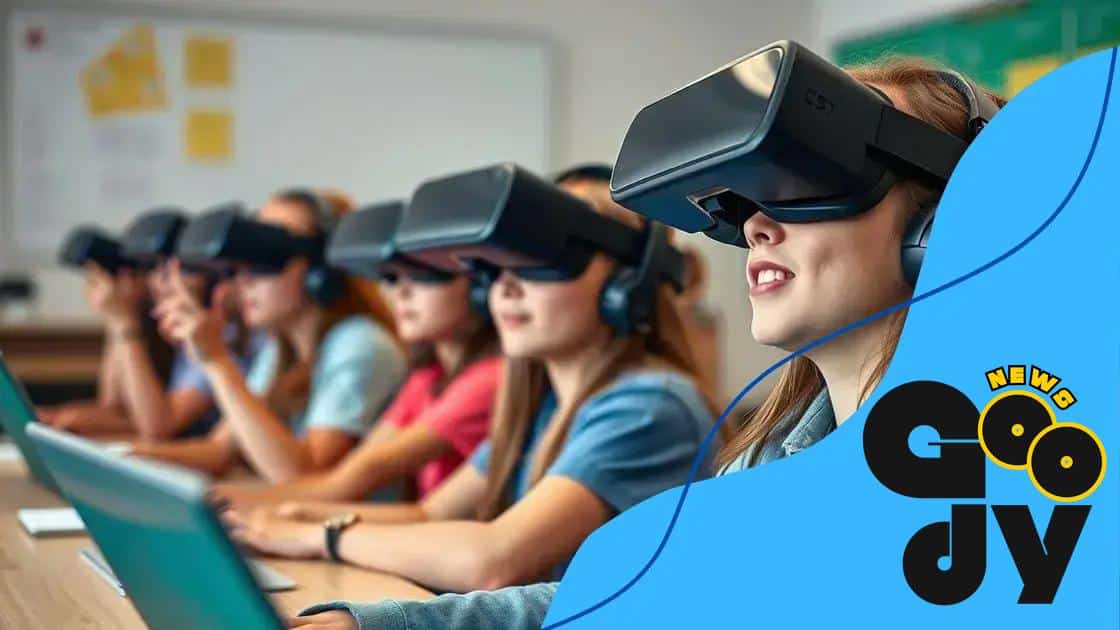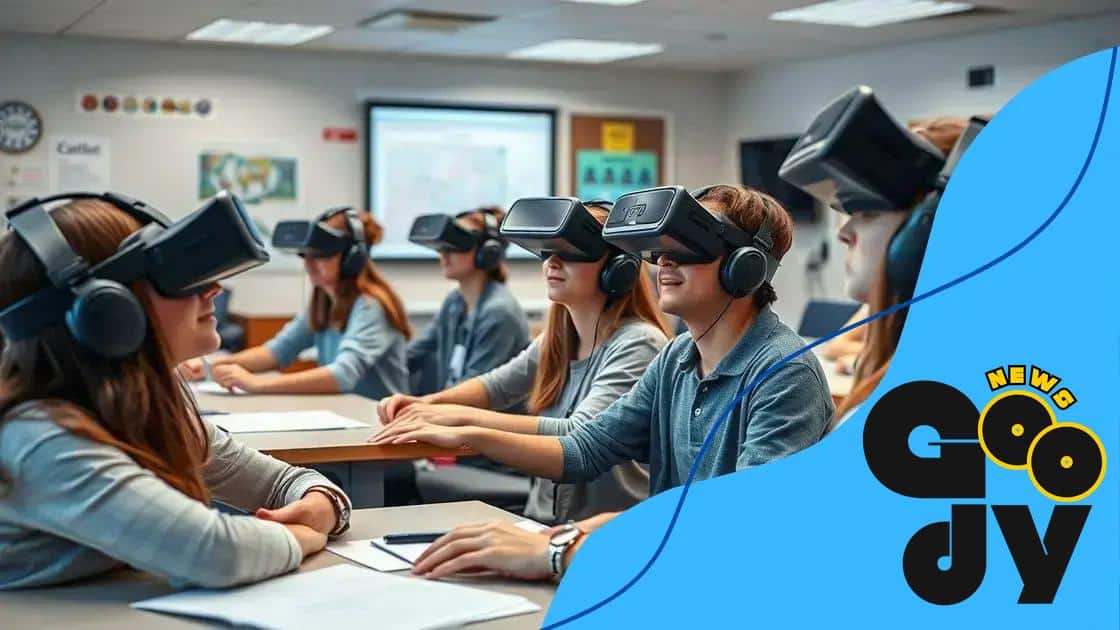Virtual reality in STEM education: a transformative approach

Virtual reality in STEM education enhances student engagement, facilitates personalized learning experiences, and provides immersive simulations that help students understand complex concepts effectively.
Virtual reality in STEM education is opening up new horizons for students and educators alike. Imagine exploring the depths of the ocean or walking on Mars without ever leaving the classroom. This cutting-edge technology offers immersive experiences that can truly change how we learn.
Understanding virtual reality in education
Understanding virtual reality in education is crucial for educators and students alike. This technology allows for immersive learning experiences that can transform the educational landscape. By creating a simulated environment, virtual reality can enhance understanding and engagement in various subjects.
What is Virtual Reality?
Virtual reality (VR) involves using a computer-generated environment that simulates physical presence in real or imagined worlds. Users wear headsets that provide 3D visual experiences, allowing them to interact with the environment. This technology can be applied in numerous educational settings, making learning more interactive and engaging.
Benefits of VR in Education
The integration of VR in classrooms offers a multitude of advantages:
- Increased engagement through interactive simulations.
- Enhanced understanding of complex concepts.
- Facilitation of experiential learning opportunities.
- Collaboration among students in virtual settings.
By immersing students in realistic scenarios, VR caters to various learning styles and encourages exploration. Imagine a biology class where students can explore the human body in 3D or a history lesson bringing ancient civilizations to life.
Moreover, engaging with VR can lead to better retention of information. Students are more likely to remember what they experienced firsthand rather than what they read from a textbook. This hands-on approach fosters critical thinking and creativity, essential skills for future careers.
How VR Enhances STEM Education
In particular, STEM education benefits significantly from this technology. For instance, simulations can demonstrate scientific concepts, allowing students to experiment without the limitations of a physical lab. They can conduct virtual chemistry experiments or build mathematical models in a 3D space.
This form of learning not only makes education more enjoyable but also bridges the gap for students who may struggle with traditional teaching methods. As a result, VR becomes a valuable tool in reaching every learner, regardless of their background.
Benefits of virtual reality for STEM learning
The benefits of virtual reality for STEM learning are transforming the way students engage with complex subjects. By creating immersive experiences, VR enhances understanding and retention of knowledge in science, technology, engineering, and math.
Enhanced Engagement
Virtual reality captivates students’ attention far more than traditional teaching methods. With immersive environments, students can explore concepts in a way that feels real. This higher level of engagement leads to increased interest in STEM fields.
Improved Understanding
Experiencing concepts through VR allows for practical application of theories. For example, students can visualize and interact with 3D models, which can make difficult subjects more approachable.
- Students can walk through the solar system to learn about planets.
- They can conduct virtual chemistry experiments safely.
- Mathematical concepts can be illustrated in 3D, making them easier to grasp.
These interactive experiences simplify complex concepts, allowing students to develop a deeper understanding of the subjects they study.
Moreover, VR facilitates experiential learning, promoting problem-solving skills and critical thinking. Students can experiment in a risk-free environment, encouraging exploration and curiosity. This hands-on approach inspires creativity, which is vital in STEM fields.
Personalized Learning Experiences
Virtual reality caters to different learning styles. Visual learners benefit from 3D simulations, while kinesthetic learners thrive through interactions. VR makes it easy to tailor educational experiences to individual needs.
Ultimately, the adaptability of virtual reality promotes inclusivity in education. It reaches a diverse range of students, bridging gaps for those who may struggle with conventional methods. By incorporating VR into STEM education, schools can foster a more inclusive and engaging learning environment.
Practical applications of VR in classrooms

The practical applications of VR in classrooms are helping educators adopt new teaching methods. By utilizing virtual reality, teachers can create immersive experiences that make lessons more engaging and effective.
Interactive Learning Environments
One of the most significant uses of VR in education is creating interactive learning environments. Students can explore historical sites, conduct virtual science experiments, or even travel inside the human body. These experiences are not only exciting but also enhance understanding of the material.
Real-World Simulations
Virtual reality allows for real-world simulations that can prepare students for future careers. For instance:
- Medical students can practice surgeries in a safe, simulated setting.
- Engineering students can design and test projects in a virtual lab.
- Students studying environmental science can witness climate changes firsthand.
These practical simulations provide hands-on experience that traditional classrooms may lack, giving students the confidence to apply their knowledge in real situations.
Moreover, VR can accommodate various learning styles. Visual learners can benefit from seeing concepts in 3D, while auditory learners can engage with narratives within virtual environments. This adaptability helps each student learn in a way that suits them best.
Diverse Collaboration Opportunities
VR also fosters collaboration among students. By using virtual classrooms, students from different locations can work together on projects. They can engage in group discussions, tackle challenges, and share knowledge, all while feeling as if they are in the same room.
This collaboration breaks down geographical barriers and promotes teamwork, essential skills for the modern workforce. As a result, students learn to communicate effectively and think critically within diverse groups.
Challenges in implementing VR in STEM
Implementing VR in STEM education comes with several challenges that educators must navigate. While the potential benefits are significant, understanding these hurdles is crucial for successful integration.
High Costs of Technology
One of the main challenges is the high cost associated with VR technology. The initial investment for VR headsets, software, and maintenance can be substantial, making it difficult for some schools to afford these resources. Additionally, schools may require ongoing funding for updates and repairs.
Training for Educators
Another significant hurdle is training teachers to use VR effectively. Many educators may not have experience with this technology and need proper training to integrate it into their lesson plans.
- Professional development courses are essential for effective VR implementation.
- Teachers need to understand how to create immersive lessons that align with curriculum standards.
- Support from tech experts can help educators overcome initial obstacles.
Without proper training, the potential of VR can be diminished, and teachers may feel overwhelmed by the technology. This can lead to resistance in adopting new methods.
Technical Issues
Technical difficulties can also pose challenges. Connectivity issues and software glitches can disrupt lessons and frustrate both teachers and students. Having a reliable technical support system is essential for smooth operation. Educators need to be prepared for potential setbacks and have contingency plans in place.
Additionally, not all students may have equal access to the technology. Factors such as socioeconomic status can create disparities in learning opportunities, limiting the effectiveness of VR in some schools.
Despite these challenges, overcoming them is possible with proper planning and resources. Collaborations with tech companies, community support, and dedicated training can pave the way for a successful VR implementation in STEM.
Future trends of VR in educational programs
The future trends of VR in educational programs look promising as technology continues to advance. Educators and tech developers are finding innovative ways to use virtual reality, making learning more immersive and interactive.
Increased Accessibility
One trend is the push for increased accessibility to VR technology. As prices decrease and more schools adopt VR, students from various backgrounds will have the opportunity to experience this form of learning. This democratization of technology ensures that all students benefit from immersive experiences.
Personalized Learning Experiences
Another significant trend is the development of personalized learning experiences through VR. This technology allows students to learn at their own pace, accessing resources tailored to their individual needs.
- Adaptive learning software can adjust difficulty levels based on student performance.
- Teachers can create custom content for specific subjects or projects.
- VR tutorials and simulations provide hands-on practice that suits each learner.
These personalized experiences help engage students more deeply, increasing motivation and improving learning outcomes.
Integration with Other Technologies
Future educational programs are likely to integrate VR with other advanced technologies, such as artificial intelligence (AI) and augmented reality (AR). This combination can create hybrid learning environments that enhance the learning experience.
For example, AI can analyze student performance data and make recommendations for VR content that addresses their weaknesses. AR can supplement VR experiences by overlaying additional information in a student’s physical environment.
Focus on Collaboration and Social Learning
As VR technology evolves, there is a growing emphasis on collaboration in virtual spaces. Future educational programs may feature enhanced social learning opportunities that allow students to interact with peers in realistic settings.
Virtual classrooms can enable students to work on group projects and share ideas from anywhere in the world. This global collaboration prepares students for a connected workforce and encourages the exchange of diverse perspectives.
FAQ – Frequently Asked Questions about Virtual Reality in STEM Education
What are the main benefits of using VR in classrooms?
VR enhances engagement, allows for immersive learning experiences, and helps students understand complex concepts better.
How can VR support personalized learning?
VR can tailor educational experiences to meet individual student needs, allowing them to learn at their own pace.
What challenges are associated with implementing VR in education?
Challenges include high costs, the need for teacher training, technical issues, and ensuring equal access for all students.
What future trends can we expect for VR in education?
Future trends include increased accessibility, integration with other technologies, and enhanced collaboration in virtual learning environments.





